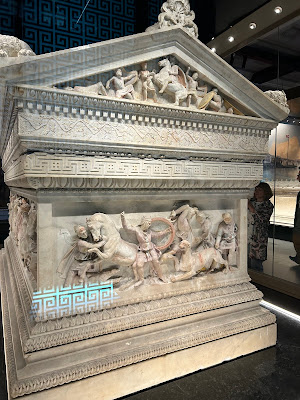The Istanbul Archaeological Museum is one of the hidden gems of Istanbul.
Tucked away next to the Topkapi Palace, it was originally founded in A.D. 1869 based on a visit Abdulaziz made to London in A.D. 1867. Impressed by what he saw, he decreed a similar museum be created in the Ottoman Empire to house the items that had been building up during the last 350 years or so in the former church of St. Irene (Haghia Irene) which was used as an arsenal and storage facility. The museum currently consists of three different facilities, the Museum of the Ancient Orient, the Museum of Islamic Art, and the Archaeological Museum.
The first curator of the museum in A.D. 1881 was
Osman Hamdi Bey (A.D. 1842 - 1910). Considered the first modern archaeologist of the Ottoman Empire (and thus Turkey), his curatorship and work from A.D. 1881 contributed greatly to the collection of the museum. He was also a well respected painter; up to A.D. 2019 his painting
The Tortoise Trainer held the record of the most valuable Turkish painting.
The museum itself was a foretaste of what we would realize about Turkey: There is a great deal of history in Turkey and the Anatolian plateau, far beyond what likely most Americans associate with "Turkey". The sculptures above and below are all drawn from Greek/Roman times, for example.
A tomb of purple marble. This sort of stone was known as porphyry (purple) in Greek. In the Byzantine Empire, there was a room in the palace which was completely made of this stone. Those born in the room were considered porphyrygennetos, or literally "born to the purple" (e.g. of royal lineage).
One of the more innovative exhibits was this wall replicating soil layers. Artifacts were placed in the layers below modern ground that they were discovered. You can see someone in the back left hand corner to give some idea of scale.
The jewels of this museum are the Sarcophagi. A total of 21 were discovered at the Royal Necropolis of Ayaa near ancient Sidon (current Lebanon) of the royalty and nobles of Ancient Sidon. They cover a swath of history in the Ancent Mediterranean. What was even cooler was that I realized that I had seen pictures of some of these.
Below is one of the more famous and well photographed, the so-called Alexander Sarcophagus. It is estimated to have been constructed between 331 B.C. and 311 B.C. and made for either Abdalonymus, King of Sidon appointed by Alexander, or Mazeus, a governor of Babylon.
This side possibly represents the Battle of Gaza (320 B.C.) in which Abdalonymus was slain.
One side shows the Battle of Issus (331 B.C.) and includes Alexander.
A lion hunt, with either Abdalonymus or Mazeus:
The other side shows a lion hunt.
An interesting note is that this coffin was originally painted (you can see traces in the first photo). Below is a picture of a recreated paint scheme:











Ah! More photos from Turkey, excellent TB. That sarcophagus shows the skills of some sculptor/s.
ReplyDeleteNylon12, if you look up the sarcophagus on Wikipedia, they actually think up to six sculptors had a hand in its carving - not surprising when literally everything was done by hand.
DeleteWhen I was in Greece this spring, I saw many colorized representations of how various things looked "back in the day". It was hard to wrap my mind around that from decades of visualizing things in black and white stone so to speak.
ReplyDeleteEd, it really is a change in perspective - for our culture, we value the "purity" (as it were) of the color of the original stone. The Greeks and Romans were like "Nope, we want color on that as well". I wonder if if derives from the fact that with only natural building materials - stone, wood, clay, marble - color was not available in the panoply of shades that we have today.
DeleteThis is far off your topic except for Turkey. Yesterday I wander and found a dog that originate in Turkey. Very, very large dogs but beautiful. Turkey is represented with such a very impressive breed. They are called Turkish Anatolian Shepherd. Not for town life.
ReplyDeleteAnon - Dogs (and animals) are never off topic here!
DeleteI have heard of and seen pictures of the Anatolian Shepherd, but never seen one in person. They look (and sound) amazing.
Never had a animal that wasn't a rescue. Had 9 cats and dogs and 13 horses.
ReplyDeleteAnon, that is pretty much us now as well. All of our current pets and many of the previous ones have been rescues. There is such a need.
DeleteA gem, indeed. But then, most museums are. The soil layer wall is especially interesting. As is the painting of the coffin. Can't help but wonder what they used for paint.
ReplyDeleteLeigh, I suspect many tourist groups do not stop here, given the wealth of history that is in this area. Which is unfortunate.
DeleteThrough the literature of the Ancients, we know there was a thriving art of painting; sadly the mediums are subject to decay and and destruction and so barring the rare survival in unsealed tombs or buildings (such as Herculaneum or Pompeii or the Tomb of Philip II) or extreme climates (such as the Fayum Mummy Portraits), we have only the records of the artists and verbal descriptions of what they painted.